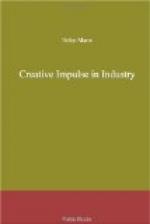some slight increase in the test; but it required
a constant urging upon our part to focus the attention
of the men upon this three minute time of low pressure....
We realized finally that in order to get the results
we were after, it was necessary for us to produce
a desire upon the part of our men to do
this work in the proper way ... so we designed an
instrument which would give us a record of the
time lost between pressing operations, also the
number of minutes the low pressure was kept on.
It took us something over a year to perfect this machine,
but after it was finally perfected and a record of
the operations made, we found that the men actually
were operating at an average efficiency of 42
per cent, and our moisture test was running about
54 per cent. Our next step was to post a daily
record of the relative standing of the men in the
machine room, putting the men who had the best
record at the top of the list, in the order of
their weekly average efficiencies. (The efficiency
of low pressure, which proved to be the most important
factor, was computed by calling three minutes
of low pressure 100 per cent and two minutes either
way 0 per cent.) As a result of simply posting this
record our efficiencies rose to over 60 per cent and
our moisture test increased a little less than
1 per cent. Some of the best and most skilled
men had an efficiency of over 80 per cent, but
quite a large percentage of them were down below 50
per cent. We therefore decided that it was
necessary to have the foreman give more detailed
information to the men as to what the machine meant
and how their efficiencies were obtained and to put
the instrument which did the recording into a
glass case in the machine room where all the men
could see it. Each foreman took a portion
of the chart and one of the celluloid scales by which,
we obtained the efficiencies and explained in
detail to each one of the men how their records
were calculated. As a result of this, our
efficiency rose from 60 per cent to 80 per cent in
less than four weeks, and it has remained at 80
per cent ever since—(ever since being
over two years)—enabling us to get a moisture
of over 56 per cent."[A]
[Footnote A: Bulletin of the Taylor Society—March,
1917.]
This was accomplished, Mr. Wolf told them, without
resorting to piece work or bonus or any of the special
methods of payments, their men being hired by the
day throughout the entire plant. Mr. Wolf accomplished
the result by giving meaning to a meaningless task,
by letting the men see for themselves how they arrived
at results, letting them see the different processes
of getting results and knowing on their own account
which were the most valuable.
There may be other managers who appreciate the value
of letting men in on the experimental effort of getting
results but it is not the practice to do so and it
is opposed to the idea of transferring the responsibility
from the workshop to the manager’s office or
laboratory. Because of this practice the educational
value of establishing standards of workmanship is
lost so far as the workers are concerned. Mr.
Wolf’s criticism of orthodox scientific management
and his conclusions are illuminating; they are indeed
revolutionary in nature as they come from a manager
of a successful industrial enterprise:




